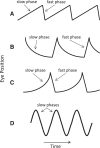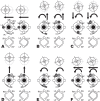Classification of vestibular signs and examination techniques: Nystagmus and nystagmus-like movements
- PMID: 31256095
- PMCID: PMC9249296
- DOI: 10.3233/VES-190658
Classification of vestibular signs and examination techniques: Nystagmus and nystagmus-like movements
Abstract
This paper presents a classification and definitions for types of nystagmus and other oscillatory eye movements relevant to evaluation of patients with vestibular and neurological disorders, formulated by the Classification Committee of the Bárány Society, to facilitate identification and communication for research and clinical care. Terminology surrounding the numerous attributes and influencing factors necessary to characterize nystagmus are outlined and defined. The classification first organizes the complex nomenclature of nystagmus around phenomenology, while also considering knowledge of anatomy, pathophysiology, and etiology. Nystagmus is distinguished from various other nystagmus-like movements including saccadic intrusions and oscillations.View accompanying videos at http://www.jvr-web.org/ICVD.html.
Figures




References
-
- Nystagmus, in: Dorland’s Illustrated Medical Dictionary, W.B. Saunders Comany, Philadelphia, 1994, pp. 1164.
-
- Committee for the Classification of Eye Movement Abnormalities and Strabismus (CEMAS) Workshop, in: A Classification of Eye Movement Abnormalities and Strabismus (CEMAS), National Eye Institute, 2003. Accessed 23 January 2017. https://www.nei.nih.gov/sites/default/files/nei-pdfs/cemas.pdf
-
- Nystagmus, in: The American Heritage Dictionary of the English Language, Houghton Mifflin Harcourt, 2011.
-
- Nystagmus, in: Merriam-Webster Online Edition, Merriam-Webster, Inc., 2013. Accessed 31 August 2013. www.merriam-webster.com/dictionary/nystagmus
-
- Nystagmus, in: Oxford Dictionaries, Oxford University Press, 2013.
Publication types
MeSH terms
LinkOut - more resources
Full Text Sources
Other Literature Sources
Medical

